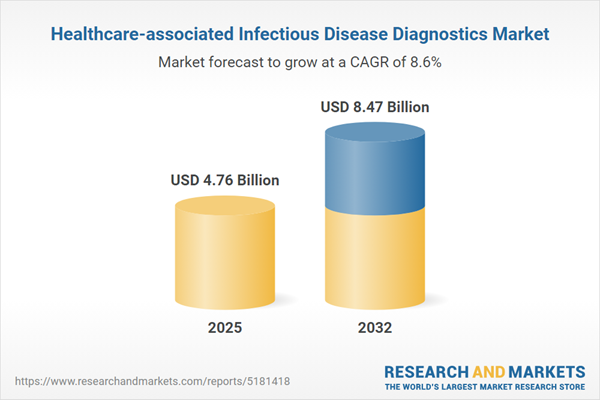Speak directly to the analyst to clarify any post sales queries you may have.
Senior decision-makers face a swiftly shifting landscape as healthcare-associated infectious disease diagnostics evolve to meet the ongoing needs of global health systems. This report provides strategic clarity and actionable intelligence for leaders navigating rapid technological advancements, changing regulatory requirements, and increasing supply chain complexity in this critical market.
Market Snapshot: Healthcare-Associated Infectious Disease Diagnostics
The Healthcare-associated Infectious Disease Diagnostics Market grew from USD 4.37 billion in 2024 to USD 4.76 billion in 2025. It is expected to continue growing at a CAGR of 8.60%, reaching USD 8.47 billion by 2032. Market momentum is driven by the transition to molecular and immunoassay platforms, growing prevalence of healthcare-associated infections, and the rising demand for faster, more precise diagnostic solutions that support patient safety and containment strategies.
Scope & Segmentation
This in-depth research covers the full spectrum of technologies, applications, and users within healthcare-associated infectious disease diagnostics:
- Test Methods: Immunoassays (chemiluminescent immunoassay, ELISA, lateral flow assays), microbiology (culture: aerobic and anaerobic, microscopy, sensitivity testing), and molecular diagnostics (isothermal amplification, PCR, sequencing).
- Pathogen Types: Bacterial (Clostridium difficile, Escherichia coli, Pseudomonas aeruginosa, Staphylococcus aureus), fungal (Aspergillus, Candida, Cryptococcus), parasitic (malaria, Toxoplasma gondii), and viral (coronavirus, influenza, norovirus, respiratory syncytial virus) targets.
- End Users: Diagnostic laboratories (independent and reference), hospitals (clinical pathology and microbiology labs), and point-of-care settings (clinics, emergency departments, long-term care facilities).
- Sample Types: Blood (serum, whole blood), cerebrospinal fluid, respiratory (bronchoalveolar lavage, nasopharyngeal swabs, sputum), urine (catheterized, midstream), and wound swabs (deep tissue, surface).
- Geographical Regions: Americas (United States, Canada, Mexico, Brazil, Argentina, Chile, Colombia, Peru), Europe, Middle East & Africa (United Kingdom, Germany, France, Russia, Italy, Spain, Netherlands, Sweden, Poland, Switzerland, United Arab Emirates, Saudi Arabia, Qatar, Turkey, Israel, South Africa, Nigeria, Egypt, Kenya), and Asia-Pacific (China, India, Japan, Australia, South Korea, Indonesia, Thailand, Malaysia, Singapore, Taiwan).
- Major Companies: Roche Diagnostics International AG, Abbott Laboratories, Danaher Corporation, Thermo Fisher Scientific Inc., Siemens Healthineers AG, Becton, Dickinson and Company, bioMérieux SA, QIAGEN N.V., Bio-Rad Laboratories, Inc., DiaSorin S.p.A.
Key Takeaways for Decision-Makers
- Molecular diagnostics and immunoassay technologies continue to gain prominence, transforming both centralized laboratory workflows and decentralized, point-of-care environments.
- Diagnostic platforms are seeing increased integration with digital health records, enabling prompt interventions and data-driven infection control initiatives.
- Segmentation by pathogen type and application allows stakeholders to match product development with region-specific needs and evolving clinical practices.
- Regional market strategies must address local regulatory, reimbursement, and infrastructure realities, with particular opportunity in Asia-Pacific and emerging African geographies.
- Developments in artificial intelligence and predictive analytics support proactive disease surveillance and laboratory efficiency.
- Strategic alliances, regional manufacturing hubs, and investment in digital learning for staff are strengthening operational resilience and competitive positioning.
Tariff Impact on Supply Chains
Recent adjustments to United States tariffs on diagnostic reagents and equipment have prompted industry-wide supply chain recalibration. Manufacturers are diversifying sourcing, forging dual-supplier agreements, and optimizing distribution to absorb cost pressures. Laboratories increasingly seek efficiencies through reagent conservation and assay multiplexing, while industry associations collaborate with regulators to streamline import standards and negotiate waiver mechanisms for essential components.
Healthcare-Associated Infectious Disease Diagnostics: Methodology & Data Sources
The research applies both primary and secondary methodologies. Direct interviews with clinical microbiologists, laboratory managers, regulatory professionals, and procurement specialists inform strategic priorities and adoption barriers. Secondary perspectives are derived from scientific journals, industry filings, and health organization data. Rigorous triangulation and expert panels validate findings to ensure actionable intelligence.
Why This Report Matters
- Enables precise alignment of investment and R&D with current and emerging market needs in healthcare-associated infectious disease diagnostics.
- Supports resilient supply chain planning through deep analysis of regulatory and tariff-driven challenges.
- Guides strategic initiatives for technology adoption, partnership development, and market expansion aligned with local dynamics.
Conclusion
This report distills the competitive landscape, segmentation, and operational trends in the healthcare-associated infectious disease diagnostics market. Executives can act confidently on well-substantiated, regionally nuanced intelligence to drive innovation and long-term growth.
Additional Product Information:
- Purchase of this report includes 1 year online access with quarterly updates.
- This report can be updated on request. Please contact our Customer Experience team using the Ask a Question widget on our website.
Table of Contents
3. Executive Summary
4. Market Overview
7. Cumulative Impact of Artificial Intelligence 2025
List of Figures
Samples

LOADING...
Companies Mentioned
The key companies profiled in this Healthcare-associated Infectious Disease Diagnostics market report include:- Roche Diagnostics International AG
- Abbott Laboratories
- Danaher Corporation
- Thermo Fisher Scientific Inc.
- Siemens Healthineers AG
- Becton, Dickinson and Company
- bioMérieux SA
- QIAGEN N.V.
- Bio-Rad Laboratories, Inc.
- DiaSorin S.p.A.
Table Information
| Report Attribute | Details |
|---|---|
| No. of Pages | 188 |
| Published | October 2025 |
| Forecast Period | 2025 - 2032 |
| Estimated Market Value ( USD | $ 4.76 Billion |
| Forecasted Market Value ( USD | $ 8.47 Billion |
| Compound Annual Growth Rate | 8.6% |
| Regions Covered | Global |
| No. of Companies Mentioned | 10 |









